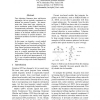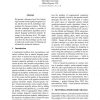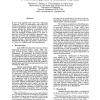COLING
2010
14 years 1 months ago
2010
We present GENSEM, a tool for generating input semantic representations for two sentence generators based on the same reversible Tree Adjoining Grammar. We then show how GENSEM ca...
EMNLP
2009
14 years 3 months ago
2009
Tree Adjoining Grammars have well-known advantages, but are typically considered too difficult for practical systems. We demonstrate that, when done right, adjoining improves tran...
ACL
2009
14 years 4 months ago
2009
We present a discourse-level Tree Adjoining Grammar which tightly integrates syntax and discourse levels, including a representation for discourse entities. We show that this tech...
GRAMMARS
2000
14 years 6 months ago
2000
In this paper we argue for a reconceptualization of the Tree Adjoining Grammar (TAG) formalism, in which the elementary structures are collections of c-command relations, and the ...
ACL
1990
14 years 7 months ago
1990
This paper presents an implemented, psychologicallyplausible parsing model for Government Binding theory grammars. I make use of two main ideas: (1) a generalization of the licens...
ACL
1992
14 years 7 months ago
1992
It has been hypothesized that Tree Adjoining Grammar (TAG) is particularly well suited for sentence generation. It is unclear, however, how a sentence generation system based on T...
COLING
1996
14 years 7 months ago
1996
In this paper we show that an account for coordination can be constructed usingthederivationstructures inalexicalized Tree Adjoining Grammar (LTAG). We present a notion of derivat...
COLING
1994
14 years 7 months ago
1994
This paper presents the XTAG system, a grammar development tool based on the Tree Adjoining Grammar (TAG) formalism that includes a wide-coverage syntactic grammar for English. Th...
ACL
1996
14 years 7 months ago
1996
Lexicalized Tree Adjoining Grammars have proved useful for NLP. However, numerous redundancy problems face LTAGs developers, as highlighted by Vijay-Shanker and Schabes (92). We p...
ACL
1997
14 years 7 months ago
1997
We present an algorithm for simultaneously constructing both the syntax and semantics of a sentence using a Lexicalized Tree Adjoining Grammar (LTAG). This approach captures natur...



